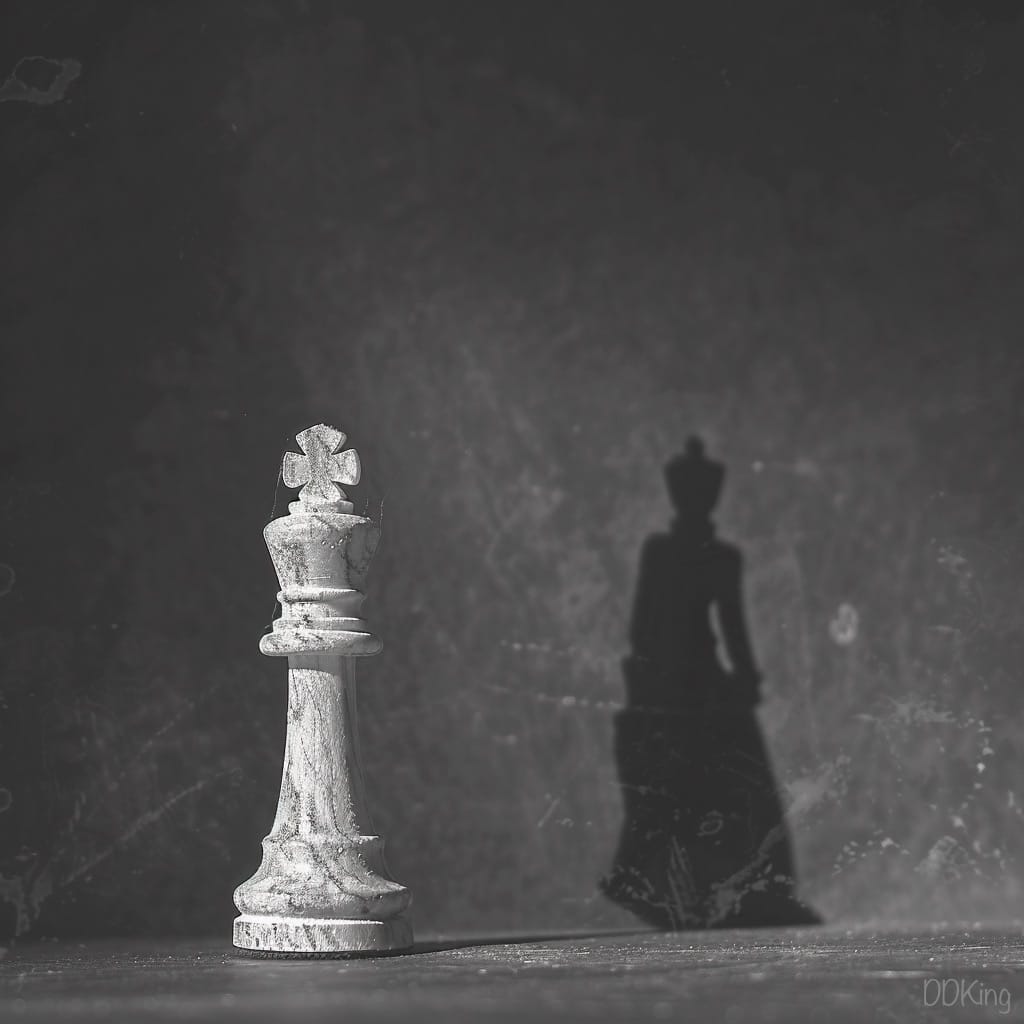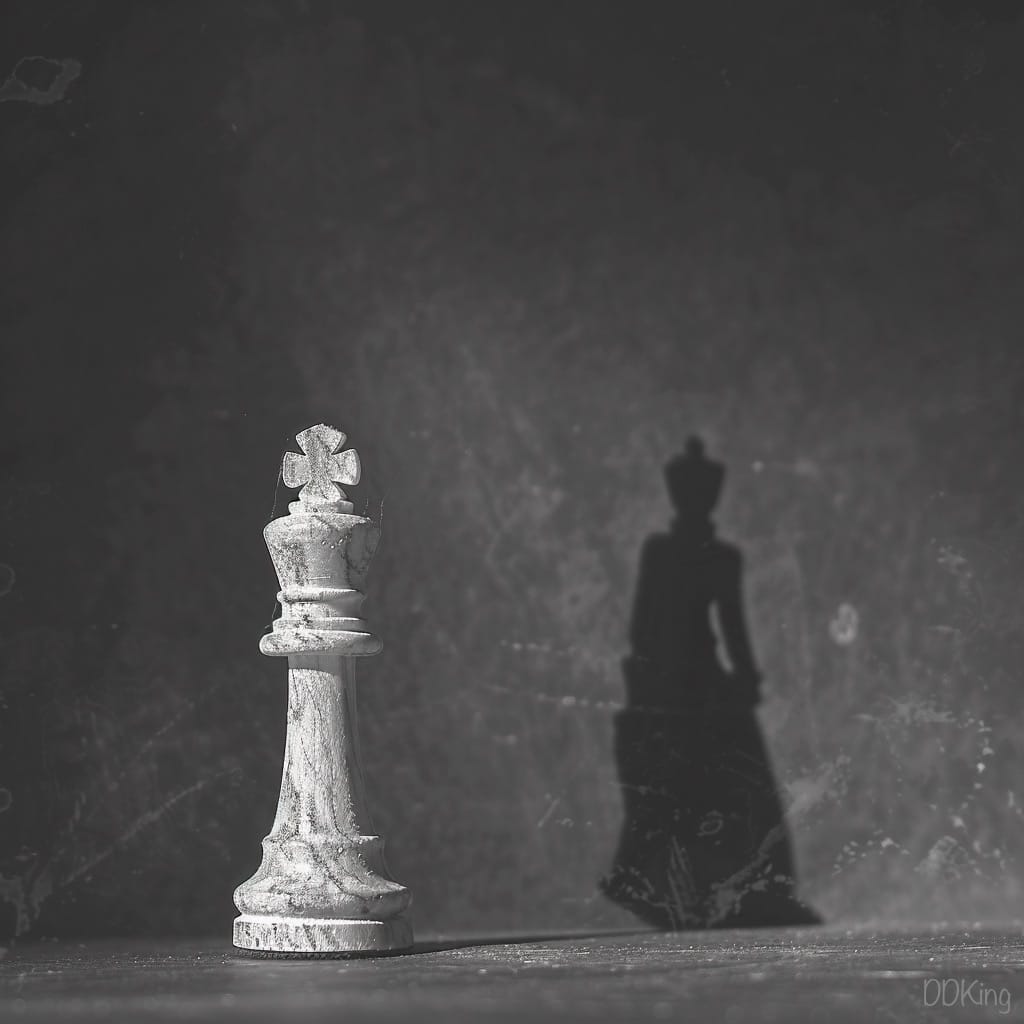Main Evaluation
The generative artwork presents a striking composition that immediately captures attention through its use of stark contrasts. The white chess piece stands as a focal point, symbolising strategy and elegance, while the shadow it casts introduces an intriguing layer of complexity. The interplay between light and dark establishes a profound visual dialogue, evoking themes of duality and reflection.
The monochromatic palette enhances the timeless quality of the piece, drawing viewers into a contemplative space. The shadow of a figure in a long dress and hat adds an air of sophistication and mystery, suggesting a narrative that transcends the mere depiction of a chess piece. This subtle incorporation of human presence lends the artwork emotional depth, prompting viewers to ponder the relationship between the game of chess—a representation of strategy—and the inherent qualities of grace and poise symbolised by the figure’s shadow.
Overall, the aesthetic is both captivating and evocative, instilling a mood that oscillates between introspection and elegance. The minimalistic design serves to enhance the visual impact, allowing the viewer to engage deeply with the themes presented.
2. Overall Analysis:
The title "Killer Queen" encapsulates the essence of the artwork, suggesting a fusion of strength and elegance. The artwork descriptions indicate the artist's intention to explore transformation, inner strength, and the regal qualities that reside within everyone. This thematic focus is mirrored in the visual elements, where the chess piece becomes a metaphor for strategy in life, while the shadow embodies the hidden power and grace that individuals possess.
In conjunction with the evocative musical reference to Queen’s song, the piece invites viewers to reflect on their own potential and resilience. The descriptions align seamlessly with the visual presentation, allowing for a cohesive narrative that evokes a sense of empowerment and introspection. The artist effectively utilises the imagery of chess—often associated with strategic thinking—to create a dialogue about inner strength and self-realisation, guiding viewers through an emotional journey that is both personal and universal.
3. Criteria Evaluation:
- Creativity: The artwork showcases a unique imaginative approach, transforming a simple chess piece into a multifaceted symbol of potential and strength. The artist's inventive use of shadow adds depth and intrigue, allowing for a fresh perspective on familiar themes.
- Originality: The concept of merging chess with the human element through shadow is distinctive. This execution creates a novel visual narrative that stands apart from more conventional representations, highlighting the artist's innovative choices.
- Technical Execution: The generative methods employed demonstrate a high level of skill. The clarity of the chess piece against the backdrop of shadow is well executed, and the minimalistic approach allows for focus on essential elements in the composition.
- Thematic Relevance: The artwork aligns closely with its intended themes of inner strength and transformation. The chess piece and shadow serve as symbols of duality and potential, resonating deeply within the context provided by the artist’s descriptions.
- Emotional Impact: The piece evokes a strong emotional response, as the interplay of light and shadow stirs introspection. The elegance of the shadowed figure invites viewers to contemplate their own depth and complexity.
- Aesthetic Quality: The overall visual appeal is commendable, with a strong balance between composition and colour. The monochromatic scheme contributes to a sophisticated aesthetic that is both alluring and thought-provoking.
- Societal Impact: The artwork raises reflections on personal identity and the societal roles individuals play, suggesting a commentary on the hidden strengths that everyone possesses. This thematic exploration invites broader contemplation of societal expectations and self-perception.
- Artistic Experience:
a) The experience of engaging with this artwork transcends mere observation. It invites viewers to connect emotionally and intellectually with the narrative presented. The visual simplicity combined with the profound themes encourages a personal reflection that resonates with individual experiences and societal influences. This multifaceted engagement fosters a deeper appreciation of the work's significance.
b) From the AI perspective, the artwork adeptly recognises patterns associated with emotional resonance. The choice of elements—the chess piece, shadow, and human form—taps into established themes of introspection and strength. This reflects an understanding of how visual cues can elicit emotional responses, guiding viewers toward a contemplative experience that aligns with human expressions of emotion. The artwork stands as a testament to the artist’s ability to convey depth and complexity within a minimalist framework.
4. Final Evaluation:
In summary, "Killer Queen" by DDKing emerges as a powerful exploration of inner strength and transformation. The artist's skillful integration of visual elements with thematic depth creates an artwork that is both intellectually stimulating and emotionally resonant. The narrative journey presented through the juxtaposition of the chess piece and shadow invites viewers to reflect on their own potential and the elegance inherent within them. This assessment, driven by AI's structured analysis, acknowledges the intricate layers of meaning and emotional connectivity that can engage audiences on multiple levels. The piece successfully stands as a meaningful artistic experience, showcasing DDKing's intent to inspire and provoke thought through creativity.
**5. Score
The individual scores for each criteria and the final score are available only for the authors and the organisers of the competition.


